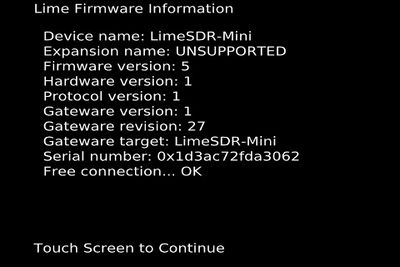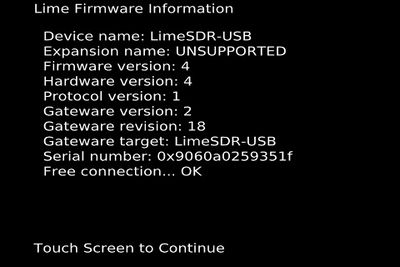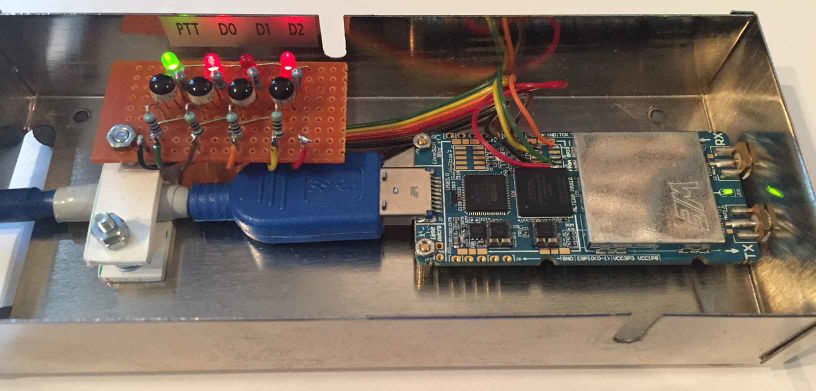Difference between revisions of "Using LimeSDR with Portsdown"
| Line 45: | Line 45: | ||
===GPIO RF Switching for Multiple Bands=== | ===GPIO RF Switching for Multiple Bands=== | ||
| − | The BATC 4-band and 8-band PTT drive and RF switching boards should continue to be used with the Lime. They can either be connected to the RPi GPIO or to the Lime FPGA GPIO. GPIOs 0, 1 and 2 give the same signals as the RPi Band LSB, NSB and MSB. GPIO 7 gives the PTT signal. These can be taken from J5 on the LimeSDR Mini https://wiki.myriadrf.org/LimeSDR-Mini_v1.1_hardware_description or J18 on the LimeSDR USB | + | The BATC 4-band and 8-band PTT drive and RF switching boards should continue to be used with the Lime. They can either be connected to the RPi GPIO or to the Lime FPGA GPIO. GPIOs 0, 1 and 2 give the same signals as the RPi Band LSB, NSB and MSB. GPIO 7 gives the PTT signal. These can be taken from J5 on the LimeSDR Mini https://wiki.myriadrf.org/LimeSDR-Mini_v1.1_hardware_description or J18 on the LimeSDR USB http://wiki.myriadrf.org/LimeSDR-USB_hardware_description. The pin connections on the LimeSDR USB are different from those on the LimeSDR Mini. |
| − | I was really impressed that, in response to a request | + | I was really impressed that, in response to a personal request, MyriadRF updated their drivers: https://discourse.myriadrf.org/t/limesdr-mini-gpio-read-not-supported/3510 allowing me to get the Portsdown to use these LimeSDR GPIOs. |
[[File:GPIO Test.jpg|816px]] | [[File:GPIO Test.jpg|816px]] | ||
Revision as of 17:38, 28 November 2018
Introduction
Being updated for upcoming release 201811300
Software version 201811300 introduces support for the Lime SDR Mini and the Lime SDR USB. Due to the limited CPU power of the Raspberry Pi, many LimeSDR transmit modes are limited to 1MS and below. For higher SRs, use of the Portsdown Filter-modulator board is recommended.
Powering the Lime
The LimeSDR (both Mini and USB versions) has a greater power consumption than the RPi can comfortably power from its USB Port, so a powered USB Hub should be used to provide power to the Lime.
Installing the Lime Software
The LimeSuite software version 18.10.0 is loaded as part of the normal Portsdown build and update process. Once installed, you can use your Portsdown to update the firmware and gateware on your LimeSDR (Mini or USB) to the compatible version.
Lime Configuration Menu
The "Lime Config" Menu is selected from Menu 3.
Selecting "LimeUtil Info" displays the current version of LimeSuite. The "Update Lime FW" button updates the Lime SDR firmware and gateware to the appropriate version for the installed LimeSuite. For Portsdown software version 201811300, the correct versions are shown below. You should see exactly the same screen after selecting "Lime FW Info".
The Lime firmware/gateware version that works with the Portsdown also works with the current version of DATV Express.
WARNING - High Power Output During Calibration Before Transmit
When the LimeSDR is put into transmit mode, it first performs a self-calibration which transmits at high power both in-band and out-of-band. It is imperative that power amplifiers are not energised during this phase or they will be damaged and/or strong illegal transmissions will be made out-of-band.
There are 2 delayed PTT signals available to help you avoid this situation. The first is on the normal Portsdown PTT pin on the RPi. The second is on GPIO 7 on the LimeSDR Mini or Lime SDR USB. None of these signals go high until calibration is finished.
Transmitting
Select Lime Mini or Lime USB from the "Output to" Menu. The detected device should be "not greyed out". On Menu 1, you will see the Lime Gain button for the appropriate band (distinct Lime Gains between 0 and 100 are stored for each band). This has yet to be calibrated, but a setting of 88 is a good starting point for between 1 and 5 dBm of output at 437 MHz.
Selecting the modulation button will allow you to choose between Carrier, DVB-S and DVB-S2 modes. Once a DVB-S2 mode is selected, the appropriate FECs are available on the FEC button. Note that different FECs are available (and not available) for different modulations.
The RPi has to work quite hard to generate the signals to drive the LimeSDR. All SRs at 1MS and below seem to be reliable, but SRs of 2MS and 4MS can suffer drop-outs, particularly in MPEG-2 transmission modes. For operation above 1MS, the Portsdown Filter-Modulator board is recommended, rather than the LimeSDR.
Limitations
There are 3 transmission modes used by the LimeSDR with Portsdown: SDR without up-sampling, SDR with 2 x up-sampling and carrier mode. I have tried to level the powers across these 3 modes, but they will vary by 2 or 3 dB depending on the SR and Lime gain selected.
There is a failure mode where the LimeSDR refuses to transmit anything other than a carrier, or does not respond at all. It has not been possible to overcome these failures yet in software; the solution is to power down the LimeSDR (by disconnecting the power and USB leads), and then to reconnect them.
GPIO RF Switching for Multiple Bands
The BATC 4-band and 8-band PTT drive and RF switching boards should continue to be used with the Lime. They can either be connected to the RPi GPIO or to the Lime FPGA GPIO. GPIOs 0, 1 and 2 give the same signals as the RPi Band LSB, NSB and MSB. GPIO 7 gives the PTT signal. These can be taken from J5 on the LimeSDR Mini https://wiki.myriadrf.org/LimeSDR-Mini_v1.1_hardware_description or J18 on the LimeSDR USB http://wiki.myriadrf.org/LimeSDR-USB_hardware_description. The pin connections on the LimeSDR USB are different from those on the LimeSDR Mini.
I was really impressed that, in response to a personal request, MyriadRF updated their drivers: https://discourse.myriadrf.org/t/limesdr-mini-gpio-read-not-supported/3510 allowing me to get the Portsdown to use these LimeSDR GPIOs.
The gain provided by the BATC 8-way RF switch is useful to maintain current levels (5 - 10 mW) at the output. There will be some component adjustments needed to ensure the correct levels are available. Details will be published soon.
On the Lime USB the output is from "TX1 Low" below 2 GHz and from "TX1 High" above 2 GHz. The Lime Mini only has a single output.
Acknowledgements
Thanks to Evariste F5OEO, Andrew Back at Myriad RF, Charles G4GUO and Malcolm G0UHY for their help in implementing this capability.


